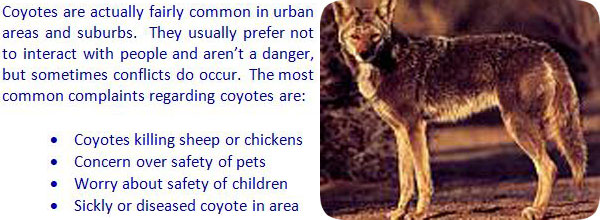- info@wildlifeanimalcontrol.com
Call us for help in your town
Wildlife Control Education
How to Catch a Coyote in a Live Trap or Foot Trap

Need coyote removal in your hometown? We service over 500 USA locations! Click here to hire us in your town and check prices - updated for year 2020.
Coyotes can cause problems for farmers who raise livestock. They like an easy meal, and will make one out of small lambs and attack chickens and cows. It will also go after small household pets. Coyotes are opportunistic omnivores, meaning they will almost anything including garbage, wild fruit, eggs, and reptiles to name a few.
The range of the coyote is a large one. It includes the continental United States, and stretches as far south as Costa Rica and also goes into much of Canada. Humans infringing on the coyote’s territory has not deterred them much. They are impressively adaptable.
Traps
Coyotes are best caught using a trap that snaps around their foot. Recommended sizes include a No. 3 or No. 4 coil spring trap with jaws that spread about six inches apart. The trap should have smooth jaws so it will not break the skin but still hold them. Traps with rubber jaws are a more humane way to catch coyotes and are harder to escape.
Traps are best set in places where the coyotes have been killing livestock. They are creatures of habit and will come back to the same place. If you leave the carcass of the animal they have killed on the ground, they may be more likely to return quickly. It is not a good idea to set traps in high grass or around trees. Coyotes are nervous about places with too much cover.
How to set a trap
• Clean your trap to ensure no human smell remains on them. Boiling is recommended.
• Find coyote tracks to determine where they are getting in to the property.
• Pick a scent to lure them with. This can include coyote gland or urine. You can also use a small amount of meat.
• Dig a small hole and place and set the trap. If you decide to use some meat, put it under the trap.
• Cover the trap carefully and make it look natural.
• Put about ten drops of the scent around the hole to attract the coyote.
• Release any animals caught that are not your target animal.
Snares
Snares are another way to catch nuisance coyotes. The snare is a length of wire fashioned into a noose-like loop. It is placed in the correct location, depending on where the coyote needs to be caught, and will close around their neck as they pass through. Snares are not normally fatal to the animals.
If you choose to use a snare, let people around you know so their dogs will not get caught. The snare is large enough to catch a medium sized dog. While snares are less likely to catch non-target animals, use caution. Get a snare made of 3/32 stainless steel cable for the most effective catch.
Set multiple snares to catch the coyote. Sometimes there is more than one animal doing the killing, and other times their entrance and exit places may be different. Make sure you inspect the perimeter of the area to see if there is more than one access spot.
How to set a snare
• Remove odors from the snare by hanging it outside for a few days or boiling it in water.
• Find the coyote tracks. If they are crawling under a fence, look for hair on the fence and a trail or hole under the fence.
• Place the snare in the chosen spot, a little off the ground. A 10 to 14 inch loop should be used.
• Set the snare and lock, and secure the swivel end to a fence or other strong structure.
• Any non-target animals you catch should be released immediately.
More on coyotes
While coyotes can be seen as a nuisance to livestock farmers and country dwellers, they do offer benefits. Rodents like mice and rats would quickly multiply and their numbers would skyrocket without having the coyote as a natural predator. They also clear yards, farms and gardens of other animals seen as pests like woodchucks and moles.
Ecologically speaking, they are an important component. The carcasses they leave can feed foxes and ravens, and they do not eliminate different species from the environment. They create a balance in the local ecosystem. If you must trap them, do so humanely.
More in-detail how-to coyote removal articles:
Information about coyote trapping - analysis and methods for how to trap.
Information about how to kill a coyote - with poison or other methods.
Information about how to keep coyotes away - prevention techniques.
Information about coyote repellent - analysis of types and effectiveness.
Read in my educational articles all About Coyotes and if they are dangerous to humans or to pets.
This site is intended to provide information about how to catch a coyote a live trap or foot trap, so that you can make an informed decision
if you need to deal with a coyote problem. This site provides many coyote capture articles and strategies, if
you wish to attempt to solve the problem yourself. If you are unable to do so, which is likely with many
cases of coyote removal, please go to the home page and click the USA map, where I have wildlife removal experts
listed in over 500 cites and towns, who can properly help you with your nuisance coyote.
Click here to
read more about how to get rid of coyotes.

















